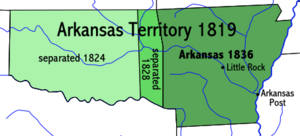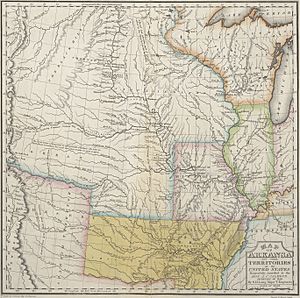Arkansas Territory facts for kids
Quick facts for kids Arkansas Territory |
|||||||||||
|---|---|---|---|---|---|---|---|---|---|---|---|
| Organized incorporated territory of the United States | |||||||||||
| 1819–1836 | |||||||||||
 |
|||||||||||
| Capital |
|
||||||||||
| Area | |||||||||||
| • Coordinates | 34°44′10″N 92°19′52″W / 34.73611°N 92.33111°W | ||||||||||
| Government | |||||||||||
| • Type | Organized incorporated territory | ||||||||||
| President | |||||||||||
|
• 1819–1825
|
James Monroe | ||||||||||
|
• 1825–1829
|
John Quincy Adams | ||||||||||
|
• 1829–1836
|
Andrew Jackson | ||||||||||
| Governor | |||||||||||
|
• 1819–1824
|
James Miller | ||||||||||
|
• 1825–1828
|
George Izard | ||||||||||
|
• 1829–1835
|
John Pope | ||||||||||
|
• 1835–1836
|
William Fulton | ||||||||||
| Legislature | General Assembly | ||||||||||
|
• Upper house
|
Legislative Council | ||||||||||
|
• Lower house
|
House of Representatives | ||||||||||
| History | |||||||||||
|
• Affirmed by Congress
|
2 March 1819 | ||||||||||
|
• Officially became territory
|
July 4, 1819 | ||||||||||
| June 30, 1834 | |||||||||||
| May 6, 1828 | |||||||||||
|
• Statehood of Arkansas
|
15 June 1836 | ||||||||||
|
|||||||||||
| Today part of | United States | ||||||||||
The Arkansas Territory was a territory of the United States that existed from July 4, 1819, to June 15, 1836, when the final extent of Arkansas Territory was admitted to the Union as the State of Arkansas. Arkansas Post was the first territorial capital (1819–1821) and Little Rock was the second (1821–1836).
Etymology
The name Arkansas has been pronounced and spelled in a variety of fashions. The region was organized as the Territory of Arkansaw on March 2, 1819, but the final extent of the territory was admitted to the Union as the State of Arkansas on June 15, 1836. The name was historically pronounced /ˈɑːrkənsɔː/, /ɑːrˈkænzəs/, and had several other pronunciation variants. In 1881, the Arkansas General Assembly passed the following concurrent resolution (Arkansas Statutes, Title 1, Chapter 4, Section 105):
Whereas, confusion of practice has arisen in the pronunciation of the name of our state and it is deemed important that the true pronunciation should be determined for use in oral official proceedings.
And, whereas, the matter has been thoroughly investigated by the State Historical Society and the Eclectic Society of Little Rock, which have agreed upon the correct pronunciation as derived from history, and the early usage of the American immigrants.
Be it therefore resolved by both houses of the General Assembly, that the only true pronunciation of the name of the state, in the opinion of this body, is that received by the French from the native Indians and committed to writing in the French word representing the sound. It should be pronounced in three (3) syllables, with the final "s" silent, the "a" in each syllable with the Italian sound, and the accent on the first and last syllables. The pronunciation with the accent on the second syllable with the sound of "a" in "man" and the sounding of the terminal "s" is an innovation to be discouraged.
Residents of Kansas often pronounce the Arkansas River as /ɑːrˈkænzəs ˈrɪvər/ in a manner similar to the common pronunciation of the name of their state.
History
On March 2, 1819, at the penultimate meeting of the 15th United States Congress, Congress passed the Arkansas organic act (3 Stat. L. 493), providing for the creation of the Arkansaw Territory on July 4, 1819, from the portion of the Missouri Territory lying south of a point on the Mississippi River at 36 degrees north latitude running west to the St. Francis River, then followed the river to 36 degrees 30 minutes north latitude, then west to the territorial boundary. This included all of the present state of Oklahoma south of the parallel 36°30' north. The westernmost portion of the territory was removed on November 15, 1824, and a second westernmost portion was removed on May 6, 1828, reducing the territory to the extent of the present state of Arkansas.
Originally the western border of Missouri was intended to go due south to the Red River. During negotiations with the Choctaw in 1820, however, Andrew Jackson unknowingly ceded more of Arkansas Territory. Then in 1824, after further negotiations, the Choctaw agreed to move farther west, but only by "100 paces" of the garrison on Belle Point. This resulted in the bend in the common border at Fort Smith.
The territory originally had nine counties: Arkansas, Clark, Crawford, Hempstead, Independence, Lawrence, Miller, Phillips, and Pulaskị.
Demographics

In the 1830 United States census, 23 counties in the Arkansas Territory reported the following population counts (after only 7 reported the following counts in the 1820 United States census):
These census counts did not include Native Americans, and the earlier count includes 1,617 slaves. Though a census of Cherokee was to be taken as part of the Jackson and McMinn Treaty in 1818, it was never conducted. Instead, when the treaty was renegotiated in 1819, it used John C. Calhoun's estimate of 5000 Cherokee in Arkansas, despite the Cherokee Nation's estimate of 3,500. The Quapaw were counted at 455 in the mid 1820s.
| 1830 Rank |
County | 1820 Population |
1830 Population |
|---|---|---|---|
| 1 | Lawrence | 5,602 | 2,806 |
| 2 | Hempstead | 2,248 | 2,512 |
| 3 | Crawford | – | 2,440 |
| 4 | Pulaski | 1,923 | 2,395 |
| 5 | Washington | – | 2,182 |
| 6 | Independence | – | 2,031 |
| 7 | St. Francis | – | 1,505 |
| 8 | Pope | – | 1,483 |
| 9 | Arkansas | 1,260 | 1,426 |
| 10 | Clark | 1,040 | 1,369 |
| 11 | Crittenden | – | 1,272 |
| 12 | Izard | – | 1,266 |
| 13 | Chicot | – | 1,165 |
| 14 | Phillips | 1,201 | 1,152 |
| 15 | Conway | – | 982 |
| 16 | Jefferson | – | 772 |
| 17 | Lafayette | – | 748 |
| 18 | Union | – | 640 |
| 19 | Sevier | – | 634 |
| 20 | Monroe | – | 461 |
| 21 | Hot Spring | – | 458 |
| 22 | Miller | 999 | 356 |
| 23 | Jackson | – | 333 |
| Arkansas Territory | 14,273 | 30,388 |
Law and government
Robert Crittenden was the territorial secretary until 1829 and the de facto territorial governor, preparing Arkansas for statehood. Until present-day Oklahoma received statehood, Fort Smith served as the ostensible legal authority overseeing the Indian Territory. The Army oversaw issues dealing with the Indian Nations.
See also
 In Spanish: Territorio de Arkansas para niños
In Spanish: Territorio de Arkansas para niños



